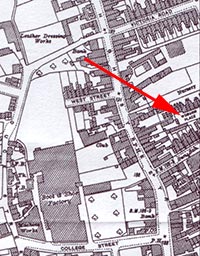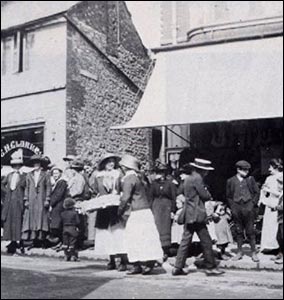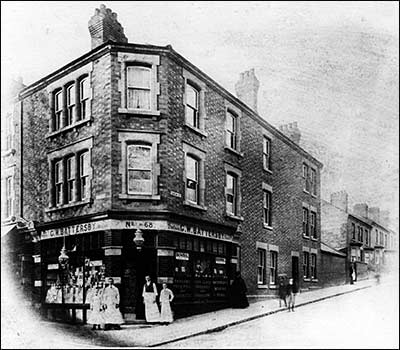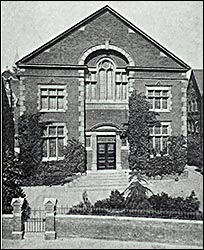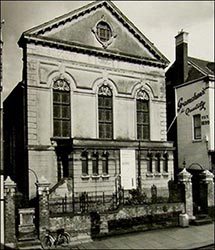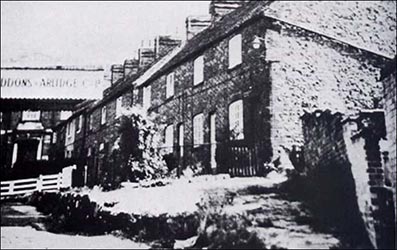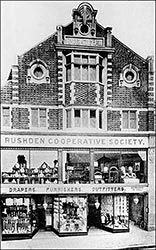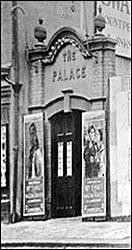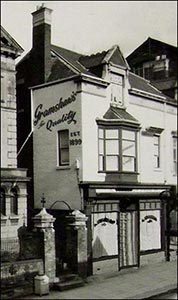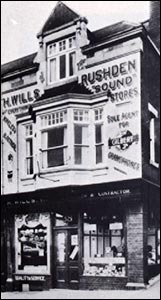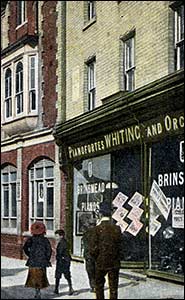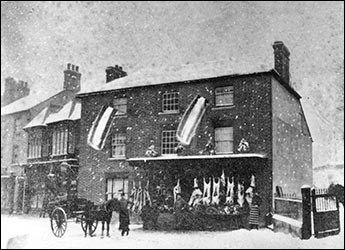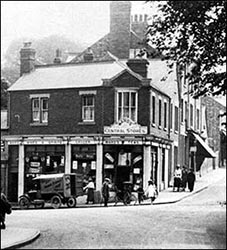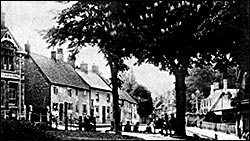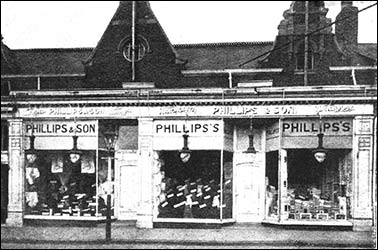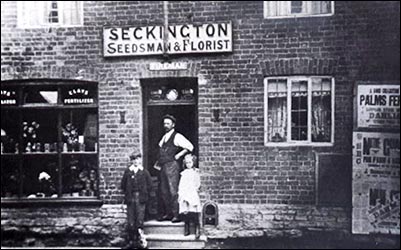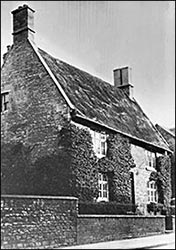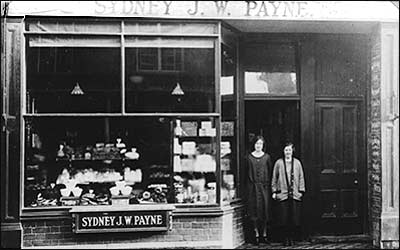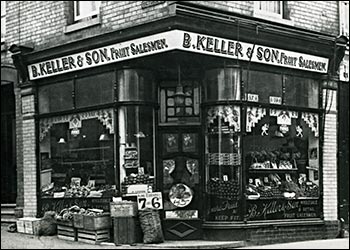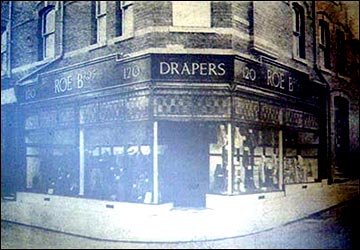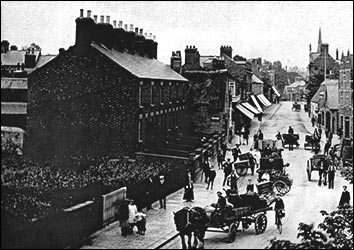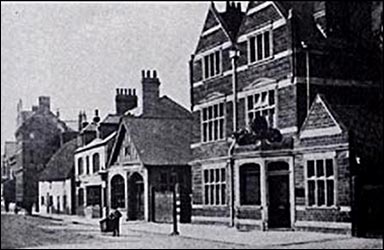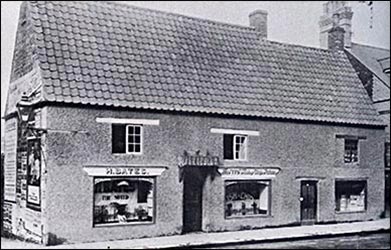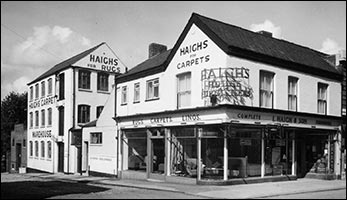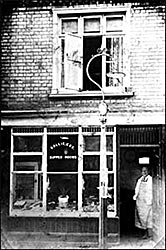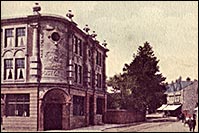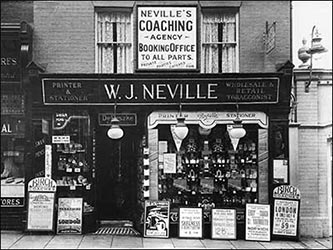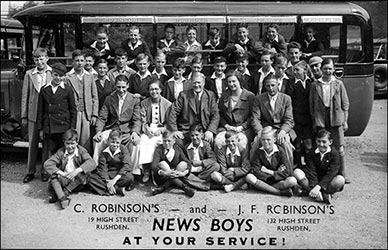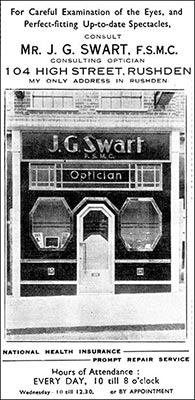|
||||||||||||||||||||||||||||||||||||||||||||||||||||||||||||||||||||||||||||||||||||||||||||||||||
| From an interview by Margaret Shelton in 2008. Transcribed by Jacky Lawrence |
||||||||||||||||||||||||||||||||||||||||||||||||||||||||||||||||||||||||||||||||||||||||||||||||||
|
Joyce Moore
|
||||||||||||||||||||||||||||||||||||||||||||||||||||||||||||||||||||||||||||||||||||||||||||||||||
|
|
||||||||||||||||||||||||||||||||||||||||||||||||||||||||||||||||||||||||||||||||||||||||||||||||||
|
||||||||||||||||||||||||||||||||||||||||||||||||||||||||||||||||||||||||||||||||||||||||||||||||||
Next door to that was the Louvre and before I went to school I went in the Louvre for my mum. Usually a reel of Silko to match this bit of material what she were making up and it were 2d. The Louvre were a lovely shop, a Mr. Walden kept it and he had a gold tooth. This gold tooth fascinated me but he were ever such a nice man, and the shop were all drawers. Whenever I went for a reel of Silko he pulled one drawer out, everything were kept in drawers. Up the stairs they sold hats, ladies hats and children’s hats and next door to that were Liptons."The shop on which the sun never sets" were on the wall in tiles and it were always crowded. They specialised in teas, there’s hundreds of little tea caddies about now from the 1924 exhibition. We had two on the mantelpiece, polished them every week, they were brass.
Then of course the Wesleyan Chapel. I never went to the Wesleyan Chapel much, I went to the Succoth Baptist, strict Baptist and I always wanted to go to the Wesleyan where all the other girls went; but no, I went strict Baptist.
After that there was Burtons, that were a lovely big grocery shop and they had a licence for drinks so you could only buy wines and spirits during the licensing hours. That were ever such a big shop, they specialised in tea. Then after Burtons, oh, there were the jewellers shop, it later became Wanklyn's which were originally the other side of the road and it’s still a jewellers shop. Then Bon Marche, they sold children’s clothes and then the Co-op shop. Oh, Willmotts, Willmotts were a big shop they sold milk, vegetables one side of the shop and sweets the other. One of the Miss Willmotts served in it, she became Mrs Newell later, and that were a big shop with red and blue tiles on the floor.
Then, there come the Succoth Chapel, it were a nice chapel. I only went to Sunday School there, I very seldom went in the evenings. I don’t remember the minister’s name but the Sunday School teacher were Mrs. Bennett and she was from Radburne and Bennetts the leather people. She taught to say the alphabet in texts "ask and it shall be given to you". Every letter of the alphabet we learned a text from it, I were perhaps only four or five. Then of course next to that were Gramshaws, they were a nice furniture shop and they sold furniture and Osnath prams. They were the best prams you could get, ever so expensive. They also had a shop the other side of the road and then, there were the opening up to George Street, I don’t think people know George Street. Wills’ wireless shop were at the bottom and on the one side of George Street were the Temperance rooms where the Temperance Band always practised.
Next to that was, well, it were two or three dress shops and then Archie Kaufman took it, they were Jewish people, they originally lived in Wellingborough and they had a shop in Wellingborough but he opened one in Rushden and they were nice clothes but they were quite cheap. Next to that there were Blunts. Blunts sold clothes and in front of Blunt’s shop was a big copper name plate with Blunt on it. Then there were Webbs, Webbs mens shop. I know Webbs were number 26 and course there were Knights the jewellers shop that were on the corner of Coffee Tavern Lane. Opposite that were the Coffee Tavern and the men that worked in factories used to take their dinner with them, people from Irthlingborough and Raunds they went in the Coffee Tavern to buy a cup of tea. They all stood at the front of the windows drinking their tea.
Then of course next there were the Griffith Street and then Dr. Davies lived in the house at the bottom of Griffith Street. Years afterwards I were married and lived across the road from there. We lived in, oh, the shop were number 20 but there were a few houses down a yard and then we lived next door to number 20 and that were number 38. Now down the other way from Woburn place were Millards’ fruit shop, they lived at the back, everybody lived on the top of the shops. Then Seckington's, that were florists, they made wreaths and bouquets and they had a little nursery that went up the back of Woburn Place. Then Tomlinson's sweet shop, that was ever such a high class shop, children didn’t spend much money in there because it were too expensive. Next to that, this is going down the right hand side, was Hedley's chemist. Now that poor Miss Hedley who served in there she were bothered with us kids because she used to give us their adverts leaflets, Gibbs Dentifrice. We used to plague her to go in this shop to get these.
Then Miss Butlin's baby-linen shop and she sold embroidery silks, transfers and when I went to school we used to go into Miss Butlin's to buy our silk. Because when we went to school you bought your own embroidery silk.
Then, of course, there were the solicitors, Wilson's had it afterwards, but I don’t remember the name of I, know there were an old lady lived there and she rode a bike and she used to go to church a lot. But she always rode a bike with an umbrella up. T thought she were old, she probably weren’t. Then there were a big ironmongers, they sold everything, paraffin, iron, everything. Next to that, that’s coming up the High Street, because I used to go out with a girl, her name were Marjorie Neal, and her house were in West Street. But the back way were the back of these ironmongers and there were a paint shop and outside of this paint shop were a rocking horse, so that’s why we played in there.
Then the bakehouse took it over and then next to that well, it were Iliffe's. That were one of my favourite shops because they had lovely stands, china stands to set the goods on in the window. They were a pork butchers and when Mrs Iliffe and her husband took it over they cooked the meat at the back and that’s where the shop were that made the bread and the cake shop and that. The only thing I didn’t like, on the wall was an alsatian’s head. I remember most the lovely stand, they’d take the ham, the ham what you’d carve on the tall ones were at the back. I can’t remember the little shop next to it what they sold, it’s only just recently been closed. Then of course there were Bugby's fish shop. Grandfather and the Bugby brothers, they kept it and Jim’s mother died when he were twelve and she were Sophie Dykes from the Rose and Crown. When she died they went and lived over the shop and they used to do their window lovely. They sold every sort of fish, the family specialised in plucking poultry. They sold all poultry and and all fish it really were a nice shop, they used to hang it outside. Then of course next to that were the pawnbrokers, there used to be a notice on this shop, it said the pledge office, it were pawnbrokers, but they sold everything. They sold lovely things, they sold all cutlery and ever such nice things, but they were a pawn shop, not that I ever, people didn’t pawn things very much then. Then of course there were the West End club down there. It were just a tin hut, my dad were a member of the West End club because he were a club man and living up Woburn Place the West End club were near. It were a wooden hut with a big stove in the room and I used to go in because while my dad were a club member, if you wanted a drink, you could take your kid in. Like Saturday night had dances there and they had a dance band and then they had concerts, Sunday nights club concerts were ever so good.
Then it was Yard's florists, they sold everything. They sold raffia seeds plants, I don’t think they sold flowers but they sold anything to do with the horticultural trade. Next to that were a shop, I’m got an idea they just sold dairy produce and then I remember Woolworth's being built. There were two or three shops there and they were pulled down. There were a butchers shop because it used to flood. The drains down Queen Street didn’t take the water and the manhole in the High Street used to come up and that butchers shop used to flood. Then there were Poole's. Poole's sold prams, tea services, toys. They were lovely windows, not bay, a rounded window. Fascinated me because I used to think, well how did they get that glass curved, and they were lovely windows, those. Next to Poole's, oh, there was Curry's, I think Curry's were there and then they moved up the street a bit further because Curry's sold bikes. I had a bike from Curry's, Hercules they were cheaper ones, but Curry's sold them. Then there were a stone wall. Oh, the Bazaar, I remember the Bazaar coming. You could walk in and a Miss Cave kept it and she wouldn’t let us kids in. ‘Go on you kids I ent ‘aving you in here.’ So we never ever went in. They sold soap and it were similar to Woolworth's and it were called Penny Bazaar. Well, there might have been things a penny. Oh, I know what they did sell a penny, which I did used to get, little celluloid dolls, a penny, tuppence and sixpence. I always dressed these dolls because my mum had always got odd bits of material and I spent hours dressing dolls. Then there were a wall, it were the gardens of some houses, you know, down Duck Street. There was a hairdresser there, a Miss Tall, but it were a lovely cottage and Miss Tall’s place were ever so nice and it were behind a stone wall.
And another ladies shop which were very high class, which had nice rounded windows were Betson's up Wellingborough Road, on the corner of Dayton Street, it were on the corner. There were Miss Mole's, the butchers and Mole's, the grocery shop, next door. But Betson's they sold children’s clothes as well. My sister and I had a red coat from there, it were ever so expensive and I remember these red coats, do you know they went on forever. Of course you only wore them for Sundays. They were lengthened, my mum lengthened them with a bit of, she called it astrakhan and new astrakhan round the collar and then, I wore my sister’s. I’m sure them red coats went on for ten years. Mrs. Betson was sister to the two Mr. Abbotts and mum made shirts. They were ever such big people you see, in the summer she made them out of material called cambric but in the winter she made them out of winceyette. When I went to the Louvre for shirt collars they were size 22. Another thing my mum done, she used to turn coats. People used to bring a coat, she used to cut it all undone, she had a sharp knife, she sat there all night. When we were children she didn’t do so much at night, machining and that, she did it in the daytime when we were at school. But my dad sharpened a little clicking knife, it were with a sharp point. She used to go down the seams and cut these coats undone and turn them the other way round so they were made out the wrong side of the material, she could usually do the lining exactly the same. But everyone she did she said the same thing, she grumbled about the pockets because to take a pocket undone and put it round the other way were very difficult. Sometimes she’d put a new collar, a velvet collar, but if she done it straight she used to charge 2/6. She cut it undone, made it up, I always think that’s why they called them turncoats. She made it up the other way of the material because the inside’s always different and it were half a crown. I know one lady; she used to meet me out of school and she’d charged this lady a half a crown and she couldn’t afford it, which was quite possible. ‘Will you come up for sixpence a week.’ So she met me out of school and we used to go and collect this sixpence a week until my dad said. ‘You’re wearing more than that out in shoe leather.’ So she had hers for two shillings. My maiden name were Rockingham, my mother’s name were Chapman and she came from Lowestoft. Her Christian name was Florence and I’ll tell you another thing, she was a big hymn singer. My two sisters and me, all our birthdays were in October, so we always had a family party for the grown-ups for the family in October and Christmas, with a piano. People all stood, round a piano and sing. My mum was ever such a big hymn singer and at the end of every party, birthday, Christmas, whether there were kids’ parties or not one of my uncles used to say. ‘Come on Florence we’ll have the hymn.’ And this hymn was "Brightly beams our Father’s mercies from the lighthouse evermore". It upsets me to hear it now. Every party we had this hymn. I went to Alfred Street School and then I went to Newton Road and then I went to the Intermediate. When I went Mrs. Hensman were headmistress and she remembered my sister. When I left I went in a shoe factory and I will say I loved machining. Grenson’s, which were high class shoes. You see all the factories in Rushden they specialised. One made Army boots, Grenson's, they’re still on, they make, they were high class and the boss of Grenson’s lived at Knuston Hall, old Zoony Green they called him. In Glassbrook Road the bottom of that Windmill was still there and I remember saying to him. ‘Well what’s that?’ And he said. ‘It’s the bottom of the windmill.’ There were houses there and me godmother lived in one of them, but I can never remember them taking it away. It seemed as if it were there for a long time, probably took it away when I were on holiday. Because see we used to go to Lowestoft a lot because me mum’s relations were there. It were just a bottom and it were apparently stone and it were painted black. The Windmill club, which was opposite, my grandfather were doorkeeper there. Then the new Windmill, were built in the 1930s. I’m sure it were 1930s and that were a lovely place when it were built. The only thing that I didn’t like were stone stairs. One entrance for the club and one entrance were for the hall and they were stone steps, I never liked them. Well me granddad, he weren’t me real granddad, me mother, me grandmother married again and he worked on the Council. He worked for Rushden, it were Urban District Council then which, and he did paths. He used to carry a ruler in his pocket so that the paths were level. When they’d repaired them the paths had to be level but it were a different gang that did the paths to the roads.
|
||||||||||||||||||||||||||||||||||||||||||||||||||||||||||||||||||||||||||||||||||||||||||||||||||
|
|
||||||||||||||||||||||||||||||||||||||||||||||||||||||||||||||||||||||||||||||||||||||||||||||||||
|
|
||||||||||||||||||||||||||||||||||||||||||||||||||||||||||||||||||||||||||||||||||||||||||||||||||
